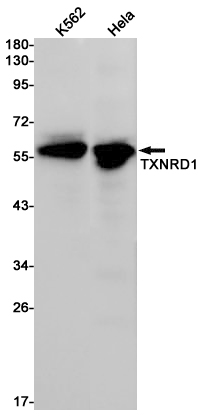Thioredoxin Reductase 1 Recombinant Rabbit mAb
Cat No.: ARM2710
 Size:
Size:

| Product Name: | Thioredoxin Reductase 1 Recombinant Rabbit mAb |
| Cat No.: | ARM2710 |
| source: | Rabbit |
| reactivity: | Human, Mouse, Rat |
| applications: | WB, IHC, ICC/IF, FC, IP |
| clonality: | Monoclonal |
| recommended dilution: | WB, IHC, ICC/IF, FC, IP |
| format: | Liquid |
| isotype: | IgG |
| immunogen: | Recombinant protein of human TXNRD1 |
| calculated molecular weight: | 67 kDa |
| observed molecular weight: | 55 kDa |
| genbank accession number: | Q16881 |
| gene id (ncbi): | 7296 |
| purification method: | Affinity Purification |
| conjugate: | Un-conjugated |
| storage: | Store at -20°C. Supplied in 50nM Tris-Glycine(pH 7.4), 0.15M NaCl, 40%Glycerol, 0.01% sodium azide and 0.05% BSA. Stable for 12 months from date of receipt. |
| synonyms: | TR; TR1; TXNR; TRXR1; GRIM-12 |
| category: | Primary Ab |
| concentration: | 1mg/ml |
| background: | The protein encoded by this gene belongs to the pyridine nucleotide-disulfide oxidoreductase family, and is a member of the thioredoxin (Trx) system. Three thioredoxin reductase (TrxR) isozymes are found in mammals. TrxRs are selenocysteine-containing flavoenzymes, which reduce thioredoxins, as well as other substrates, and play a key role in redox homoeostasis. This gene encodes an ubiquitously expressed, cytosolic form of TrxR, which functions as a homodimer containing FAD, and selenocysteine (Sec) at the active site. Sec is encoded by UGA codon that normally signals translation termination. The 3-- UTRs of selenoprotein mRNAs contain a conserved stem-loop structure, the Sec insertion sequence (SECIS) element, which is necessary for the recognition of UGA as a Sec codon rather than as a stop signal. Alternative splicing, primarily at the 5-- end, results in transcript variants encoding same or different isoforms, including a glutaredoxin-containing isoform that is predominantly expressed in testis. [provided by RefSeq, May 2017] |

